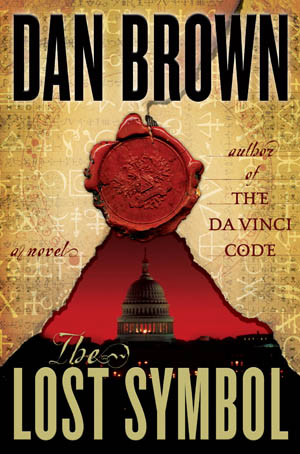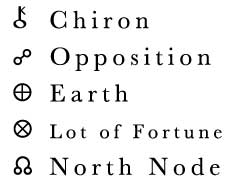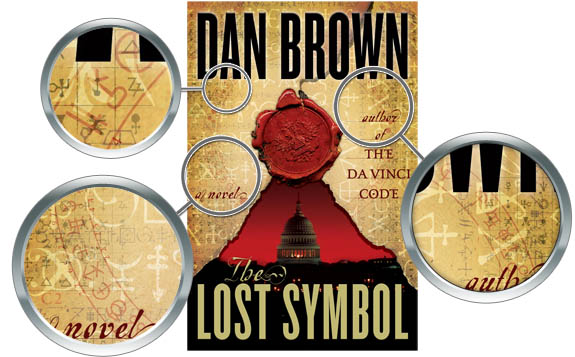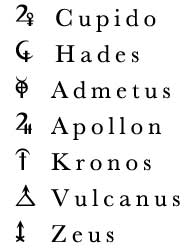 Dan Brown, author of The Da Vinci Code, recently released his latest book titled The Lost Symbol, and the story contains a number of references to astrology.
Dan Brown, author of The Da Vinci Code, recently released his latest book titled The Lost Symbol, and the story contains a number of references to astrology.
The novel is the latest installment in a series of stories featuring the main protagonist Robert Langdon, who is supposed to be an expert in religious symbology. Basically, Langdon is an expert in the meaning underlying symbols, and much of the plot development in Brown’s novels revolves around this.
Unfortunately it seems that Brown did not consult with a symbologist when he approved the cover design for his latest book, since for some reason it prominently features several astrological glyphs or symbols for “hypothetical planets”, or as I like to call them, planets that probably do not exist.
Luckily the old adage that one shouldn’t judge a book by its cover still holds true, and the actual references to astrology in the story are a bit less problematic, at least for the most part.
Astrological Symbols on the Cover
If you pick up a copy of The Lost Symbol at a bookstore, you will immediately notice a transparent red circle around the seal in the middle of the cover. Within this circle are a bunch of symbols or glyphs, the majority of which are astrological.
Here is an image I made which highlights some of the more peculiar ones:
(click for a larger image)
Transneptunians
The majority of the astrological glyphs on the cover are usually referred to as “Transneptunians”, or ‘TNPs’ for short. Some prefer to refer to them as “hypothetical planets”.
On the cover you can make out the following hypothetical planets, or Transneptunians:
- Cupido
- Hades
- Admetus
- Apollon
- Kronos
- Vulcanus
- Zeus
The glyph for the 8th main Uranian planet, Poseidon, doesn’t appear on the cover for some reason. The glyph for Transpluto does though, although technically I don’t think that this is a Uranian planet so much as it is a hypothetical planet postulated by astrologers outside of that school.
Hypothetical Planets and Uranian Astrology
These planetary glyphs are supposed to represent “hypothetical planets” that have been detected through astrological means, but have not been discovered by astronomers yet. They were originally “discovered” by a couple of German astrologers named Alfred Witte and Friedrich Sieggrun in the early 20th century, and they became the centerpiece of what is known in Germany as the Hamburg School of Astrology, or more commonly in English speaking countries as Uranian astrology.
Since most of these “planets” were “detected” prior to the discovery of Pluto in 1930, they were referred to as “Transneptunians”, since they are supposed to be beyond Neptune, although its not clear why they are still called that.
In addition to being entirely hypothetical, the other issue with these things is that they don’t follow some key astronomical laws. For example, some of their orbits are perfect circles rather than ellipses. Why, you may ask? Because fuck Kepler’s first law of planetary motion, that’s why.
The guys at Astrodienst included them in the Swiss Ephemeris, presumably for comedic value, although they point out that their orbits are “highly unrealistic”, and also…
There are even more problems. An ephemeris computed with such elements describes an unperturbed motion, i.e. it takes into account only the Sun’s gravity, not the gravitational influences of the other planets. This may result in an error of a degree within the 20th century, and greater errors for earlier centuries.
So, to summarize, Uranian astrology is basically a small fringe group of weirdos within the astrological community that use imaginary planets – that is to say, within the larger societal fringe group of weirdos that practice astrology in general.
There are other techniques that the Uranians employ that are kind of interesting, but it all seems to get lost with the whole imaginary planet thing. In fact, that is why one of Witte’s students broke away from the Hamburg School early on and formed the Cosmobiology school, which incorporates many of the same techniques, but just without the hypothetical planets.
How Did Imaginary Planets End Up On the Cover?
Although Uranian astrology is a rather small fringe group within the astrological community, several astrological computer programs do allow the ability to calculate the hypothetical planets in charts based on the Swiss Ephemeris, which is itself based on ephemerides produced by the early Uranian/Hamburg school. Accordingly, there are a few different astrological fonts which contain characters for the Uranian planets.
What I assume happened with the cover of The Lost Symbol is that some designer found these obscure looking astrological fonts and slapped them on the front of the book. I sort of doubt that Dan Brown had any hand in it, as from what I understand it is the publisher that usually deals with the cover design when major books are published.
Still, for a book where the plot is centered on a guy who specializes in symbols, it is kind of an absurd oversight to have imaginary planets on the front cover.
Other Astrological Glyphs
Aside from the Uranian planets, other glyphs that show up on the cover are:
 Chiron, an asteroid.
Chiron, an asteroid.- The glyphs for a New Moon, Full Moon, lunar eclipse, and solar eclipse. One of these may simply be the glyph for the opposition aspect, which looks very similar.
- The Moon itself.
- Glyph for the Earth, used in heliocentric charts, which looks like a circle with a cross.
- Glyph for the Lot of Fortune or Part of Fortune, which looks like a circle with an X through it.
- The glyph for the North Node, which Brown refers to with the Latin title ‘Caput Draconis’ in the book, which means ‘Dragon’s Head’. See below for more information.
There are also some other random astrological symbols in the background such as Mercury, Venus, the Sun, etc. If you want to see the rest of the background then here is a full size version of the cover.
Using Electional Astrology to Found the Capitol
Other than the hypothetical planets on the cover, there are a few interesting references to astrology throughout the book. The longest segment is early on in chapter 6 when Langdon is giving a lecture to a group of students:
“Excellent,” Langdon said. “The mural portrays the Father of Our Country using a tripod and pulley to lay the cornerstone of our Capitol Building on September 18, 1793, between the hours of eleven fifteen and twelve thirty.” Langdon paused, scanning the class. “Can anyone tell me the significance of that date and time?”
Silence.
“What if I told you that precise moment was chosen by three famous Masons—George Washington, Benjamin Franklin, and Pierre L’Enfant, the primary architect for D.C.?”
More silence.
“Quite simply, the cornerstone was set at that date and time because, among other things, the auspicious Caput Draconis was in Virgo.”
Everyone exchanged odd looks.
“Hold on,” someone said. “You mean . . . like astrology?”
“Exactly. Although a different astrology than we know today.”
A hand went up. “You mean our Founding Fathers believed in astrology?”
Langdon grinned. “Big-time. What would you say if I told you the city of Washington, D.C., has more astrological signs in its architecture than any other city in the world—zodiacs, star charts, cornerstones laid at precise astrological dates and times? More than half of the framers of our Constitution were Masons, men who strongly believed that the stars and fate were intertwined, men who paid close attention to the layout of the heavens as they structured their new world.”
“But that whole thing about the Capitol cornerstone being laid while Caput Draconis was in Virgo—who cares? Can’t that just be coincidence?”
“An impressive coincidence considering that the cornerstones of the three structures that make up Federal Triangle—the Capitol, the White House, the Washington Monument—were all laid in different years but were carefully timed to occur under this exact same astrological condition.”
The astrological symbolism all over Washington DC is well-known, although some of the other statements here may be disputable.
For example, I find it somewhat hard to believe that the emphasis of an election would be putting the North Node (Caput Draconis) in Virgo, and I’m not sure why Brown emphasizes the placement in the above dialogue.
I think that some of the ideas here are derived from David Ovason’s book The Secret Architecture of Our Nation’s Capital, including the emphasis on the sign Virgo. I will save a more detailed analysis for another post though.
Isaac Newton and Astrology
At one point in chapter 89 Brown says that Newton was into astrology:
“So it should come as no surprise to you that an early alchemist, Rosicrucian, and mystic like Isaac Newton also considered the number thirty-three special.”
“I’m sure he did,” Langdon replied. “Newton was deep into numerology, prophecy, and astrology, but what does—”
“All is revealed at the thirty-third degree.”
While it is true that Newton was into alchemy, which sometimes involves astrology in order to time things, its still not really accurate to say that Newton was deeply into astrology. Historian of astrology Nick Campion touches upon Newton a few times in his book Astrology, History and Apocalypse, and his comments contrast rather starkly with Brown’s assessment:
Sir Isaac Newton, in the late 17th century, was a very active alchemist, but I’ve looked at all his published alchemical papers and there’s no hint that he was using astrology. (pg. 64)
Later Campion goes on to say that while he may have seen some types of celestial omens as being “warnings from God” due to his Christian background
…Newton was probably quite hostile to horoscopic astrology, and certainly didn’t practice it – and probably never really studied it either. (pg. 70)
Ben Franklin
In chapter 106 Brown does seem to get it correct that Ben Franklin was involved in astrology:
One of history’s best-known magic squares is the order-eight square published in 1769 by American scientist Benjamin Franklin, and which became famous for its inclusion of never-before-seen “bent diagonal summations.” Franklin’s obsession with this mystical art form most likely stemmed from his personal associations with the prominent alchemists and mystics of his day, as well as his own belief in astrology, which were the underpinnings for the predictions made in his Poor Richard’s Almanack.
I talked about this a little bit a few years back in an article on Ben Franklin and astrology, although I may have to revise my position on this a bit based on Nick Campion’s statement that Franklin’s almanac was purely satirical:
I’ve also seen claims that the founding fathers of America, in particular Benjamin Franklin, were astrologers, and as far as I am concerned there’s no truth in this either. Benjamin Franklin did publish an astrological almanac, Poor Richard, but it was satirical – he was mocking astrology. That much is absolutely clear. (Campion, Astrology History and Apocalypse, pg. 71)
I can already anticipate that one objection to this might be the secret societies, or supposed secret societies, that Franklin was involved in, although I really don’t know enough about the matter to comment, at least for now.
Astrology Elsewhere in the Book?
There are probably a few other references to astrology in the book that could be mentioned, although those are the main points that I wanted to cover. If you noticed something else that is worth pointing out then please let me know in the comments section below.


19 replies on “Dan Brown’s The Lost Symbol Features Astrology”
There should be a credit on the book jacket detailing who designed the cover illustration. Through the publisher this person can be connacted. It appears to be a series of overlaid transparencies. The symbols are also alchemical as well as astrological and Uranian. The wax seal is easily googleable sub voce “Ordo ab chaos” which will evidence its Masonic radix (which is the referent to the number ’33’ in the Newtonian citation). In the end it does not matter much what Dan Brown thinks as he produces fourth-rate fiction and thus the cover is the ideal idiosyncratic dressing of nonsense.
Interesting article. I had noticed the references of astrology in the book but not the cover. Did not care for the book, except as tourism purposes. When I was in Paris, I followed the route used by Langdon in the “Da Vinci Code”. It is an opportunity to see monuments and objects with different set of eyes and notice details you would not otherwise.
Yeah, it seems like a lot of people overlook the stuff on the cover. For some reason it caught my eye as soon as I saw it in the bookstore though.
I did a bit of route following when I was in Paris as well, but not as much as I would have liked. I did get to see the Zodiac of Dendera though, which made the whole trip worthwhile in it of itself. I posted some pics here: http://horoscopicastrologyblog.com/2007/05/24/the-zodiac-of-dendera/
We’ve got the book at home. Gotta read it now.
Loved this: “Why, you may ask? Because fuck Kepler’s first law of planetary motion, that’s why.”
Glad I made someone laugh with that one. I’m still waiting for the hate mail to come rolling in…
(Reposting from Facebook in response to a comment from Margherita and Fabienne about people not realizing that Brown’s books are fiction.)
I don’t know, I think that Brown himself thinks that he is mixing fiction and fact when he writes his stuff sometimes.
The thing about the Da Vinci Code is that it was largely based on a non-fiction book called Holy Blood Holy Grail, where the authors really were trying to make a historical argument about Jesus and Mary Magdalene getting together and forming a bloodline that continues to this day.
The interesting thing about that is that one of the authors of that book was Michael Baigent, who also wrote a book titled ‘Mundane Astrology’ with Nick Campion and Charles Harvey in the early 80’s. Baigent also wrote an awesome book on Mesopotamian astrology called ‘From the Omens of Babylon’ in the mid-90’s, which I would highly recommend.
So, sometimes Brown at least attempts to base his stories on actual historical arguments that people have made. Now whether or not those arguments are accurate to begin with is a different matter…
By the way, we still need Dan Brown’s birth time, so if anyone who reads this either knows him or meets him at a book signing or something, do me a favor and politely ask him for his birth time. Given the type of research that he did for this book, he should know why you are asking.
Yeah, I wonder what his ASC is. He’s got that whole British professor vibe going in his publicity pics. And a big dimple in his chin.
It seems – if memory serves me right – that a lot of modern astrologers/discoverers (ab)use ancient symbols and glyphs for their own purposes.
A whole lot of the symbols used on this book-cover appear to be reproductions (or at least variations) of ancient or medieval magical symbols, like one can find in grimoires and stuff (or f.i. Agrippa’s Occult Philosophy).
Brown (or/and his editor) is rather clever, because using such ancient symbology cann’t but atract the attention of people sensitive to this kind of information (enclosed within those symbols) to his book!
Herman
(happy New Year to all!)
There are other techniques that the Uranians employ that are kind of interesting, but it all seems to get lost with the whole imaginary planet thing. In fact, that is why one of Witte’s students broke away from the Hamburg School early on and formed the Cosmobiology school, which incorporates many of the same techniques, but just without the hypothetical planets.
According to this site, it had more to do with copyrights-
http://www.astroamerica.com/cosmo.html
Interesting. That may be true, especially when it comes to the ephemerides published by the school, although I find it hard to believe that that was the only motivating factor in creating a more barebones approach to the same system.
Ebertin also got rid of the concept of complex planetary pictures used by the Uranians, but retained the notion of simple midpoints, so there are some parts of the system that the early Cosmobiologists still employed, copyright or no copyright.
Here is a relatively complete set of Franklin’s Almanacs online for view. Worth a review before accepting Campion’s opinion on Franklin IMHO.
http://www.rarebookroom.org/Franklin.html
A friend of mine who is into Uranian astrology has asked me to put a disclaimer on here in order to point out that I’m not terribly well-versed in that particular system, which is true. I do not have much experience working with hypothetical planets…
The line of thinking goes that therefore I shouldn’t have any right to critique the system, which I can understand from a certain perspective, although given the entirely hypothetical nature of the Uranian “planets” (with perfect circular orbits) I’m not sure that my incredulity is entirely misplaced.
I could be wrong though. I could be wrong…
Hmm…very interesting. Thank you Chris:) The sphinx has something to do with the Virgo Leo cusp I remember learning at one time. The head of a woman Virgo and body of a lion Leo. Was considered auspicious.
This information is pretty interesting
The Hypothetical planets don’t have to follow the laws of gravity and planetary perturbation because they have no mass.
Aren’t they supposed to be actual physical planets that were detected though Curt?
It was a joke.
Got it. My bad.